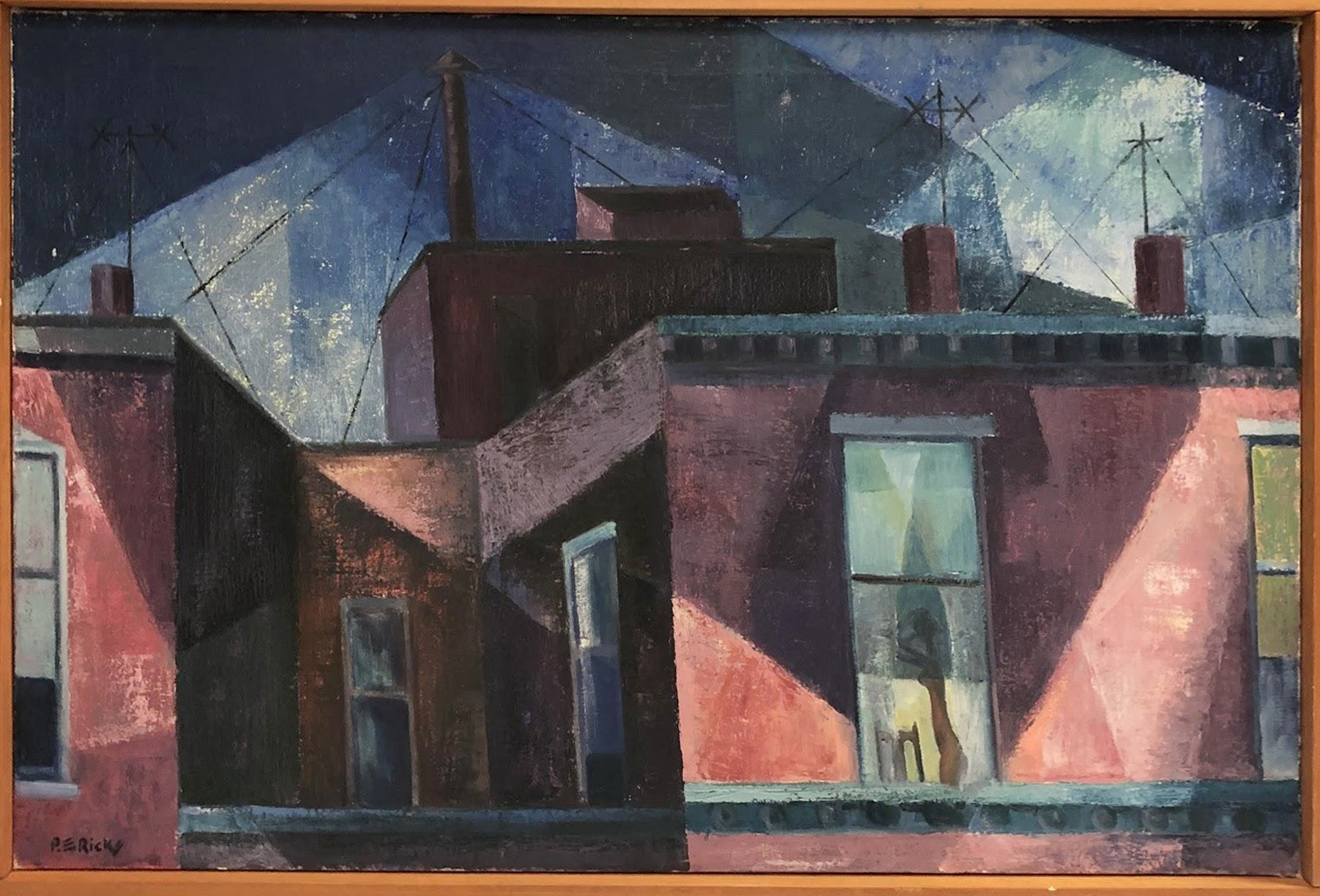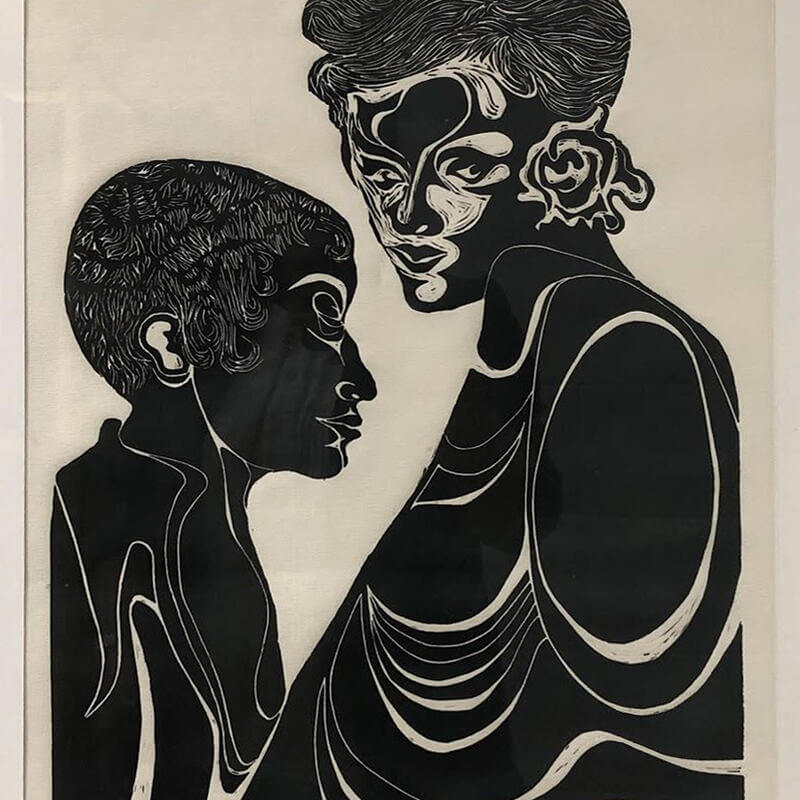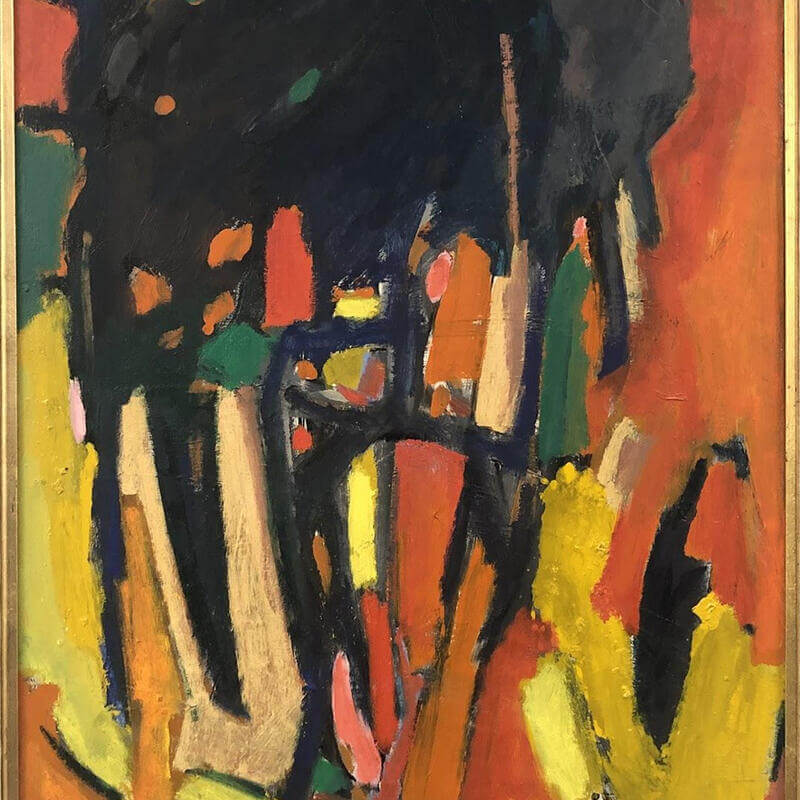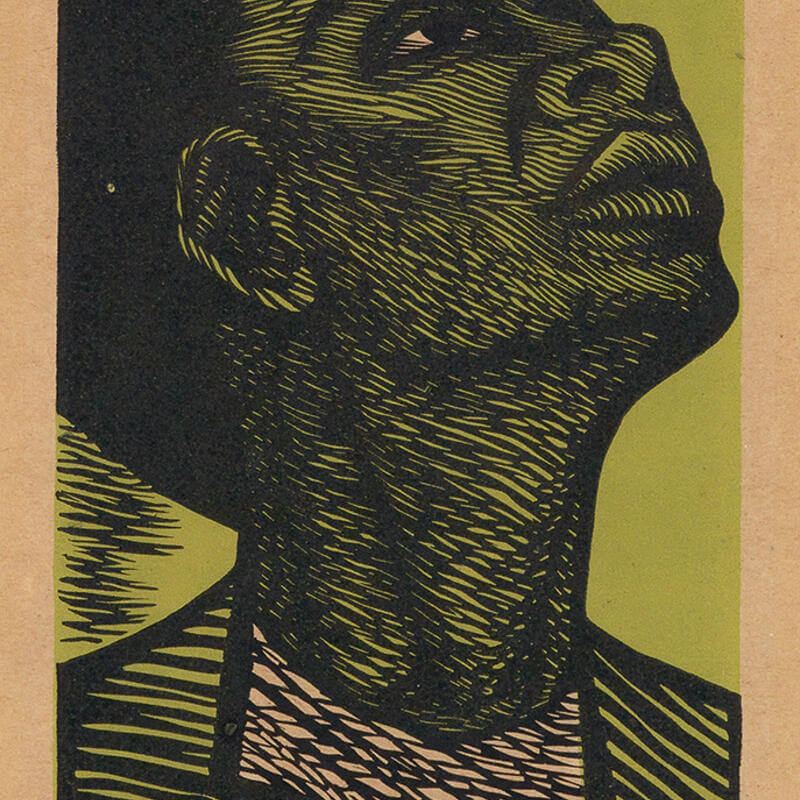James A. Porter Gallery
Honoring art historian James A. Porter, this gallery showcases Howard alumni like Elizabeth Catlett and Lou Stovall, who transformed American art.
View of Spoleto, 1975
Oil on canvas
55 x 33 in.
Lucille Malkia Roberts was an abstract painter of spectacular ability encompassing motion and perspective. Roberts viewed her art practice as a “source of positive imagery to underscore a growing sense of identity, pride, and direction” in the Black community.
Born in Washington, D.C., Roberts earned her B.A. from Howard University in 1968 and her M.F.A. from the University of Michigan in 1939. Upon her graduation she studied briefly at N.Y.U. under Hale Woodruff and returned to Howard University to teach from 1976 – 1985.
Roberts traveled extensively throughout her career, and her work was heavily influenced by African themes. While in Tanzania, she was given the Swahili name “Malkia” or “Black Queen.”
Girl, 2004
Silkscreen print
28 x 26 in.
Gwendolyn Knight was an American artist who drew inspiration from her surrounding environment, as well as from African dance, sculpture, and theater.
Knight attended Howard University from 1931 to 1933, when, because of the Great Depression, she returned to New York and studied at the Harlem Community Art Center under Augusta Savage. It was here where Knight would meet artist Jacob Lawrence, whom she married in 1941.
The couple moved to Seattle in 1971 after Lawrence accepted a professorship at the University of Washington, and they quickly became fixtures of the city’s cultural and artistic scenes, shaping generations of artists through their teachings and contributions to Seattle’s creative Black community.
Knight created portraits from a young age, and “liked to do portraits because [she] liked faces.” A 2004 print of a work originally painted in 1940, Girl demonstrates Knight’s attentiveness, care, and lyricism she afforded to all her subjects, “when I do a portrait, I want to get the feeling of a person.”
Breathing Hope, 1996
Screenprint on wove paper
16 x 16 in.
Lou Stovall was an American artist specializing in silkscreen printing, and believed this particular method of printmaking could serve a larger purpose to the artistic world, making “more art more accessible to more people.” Stovall attended Howard University from 1961 – 1965 where he studied under artists such as James Porter, Lois Mailou Jones, and David Driskell.
In 1968, with fellow artist Lloyd McNeill, Stovall opened Workshop Inc., a small silkscreen workshop focused primarily on printing posters for community events, from performances to protests. Stovall wanted the studio to serve as a community hub and sought to build unity and collaboration among artists in Washington, D.C.
In 2001, the Corcoran School of Arts and Design awarded Stovall a Doctor of Fine Arts Honoris Causa. Throughout his career, Stovall worked with artists such as Sam Gilliam, Josef Albers, Jacob Lawrence, Elizabeth Catlett, and Lloyd McNeill.
Abstraction, 1992
Oil on canvas
18 x 24 in.
Known for her texturally charged and emotional art, Sylvia Snowden’s work unites the traditions of Western abstraction with the Black American experience, and deals with the complexity of the human condition across race, gender, and class, emphasizing and celebrating our shared humanity.
Raised in New Orleans, Snowden attended Howard University for both her undergraduate and graduate degrees, studying under artists like David Driskell, James Porter, and Lois Mailou Jones, and graduated alongside Lou Stovall in 1965.
She has worked and exhibited worldwide, in Italy, Japan, France, Australia, and the Netherlands, has taught at Cornell and Yale University, and exhibited alongside fellow Howard alumni Mildred Thompson and Alma Thomas. She works primarily with acrylics, oil pastels, and mixed media to create textured works that convey the “feeling” of not only the paint but of the subject as well, “Feelings are more important to me than anything else.”
Snowden’s portfolio is available on her website, sylviasnowden.com.
Ladies of the Trappe, 1975
Woodcut
18 x 20 in.
George Smith-Shomari is a Professor Emeritus for drawing and printmaking at the University of The District of Columbia. He received his B.F.A. from Howard University in 1969 where he studied under James L. Wells, and his M.A. from Pratt Institute, where he specialized in printmaking under Jacob Lawrence.
His work, including prints, drawing, and multimedia, reflects the spirituality and experience of the African diaspora through elaborate designs and bold perspectives. Ladies of the Trappe exemplifies Shomari’s technique through his use of organic, flowing black and white lines and shapes to present a dramatic and bold image.
Shomari has taught at the Brooklyn Museum, the Brooklyn Children’s Museum, and Brooklyn College, and exhibited nationally and internationally in Mexico, Colombia, Ghana, and Venezuela.
Ladies of the Trappe was reframed through the generous support of the Helen Louise, Effie and Jerry Pettis Endowed Fund.
Tribute to Woman of Struggle, 1983
Welded steel and aluminum
68 x 46 x 5 in.
A professional sculptor, Ayokunle Odeleye, uses his art-making practices to facilitate conversations with people across the nation. His artistic passion manifests largely through public, large-scale artworks that address specific aspects of a public space while capturing an audience’s imagination.
Odeleye studied painting and sculpture at Howard University, graduating with his B.A. and M.A. in 1973 and 1975, respectively. He has held teaching positions at Dunbar High School, The Duke Ellington School for the Arts, Howard University, Spelman College, Woodland Middle School, Georgia State University, and Kennesaw State University until he retired in 2019.
Odeleye owns and operates Odeleye Sculpture Studios, where he works in both metal and wood.
Series Richard Wright Series #1: Good Boys Do Not Cry for Love, 1976
Etching
22 x 24 in.
Richard Powell received a Master of Fine Arts at Howard University in 1977 and his Doctor of Philosophy at Yale in 1988. He is the John Spencer Bassett Professor of Art and Art History at Duke University. A recipient of two Ford Foundation Fellowships, a National Endowment for the Humanities Fellowship, a Fulbright Grant, and numerous Smithsonian Institution Fellowships.
Richard J. Powell has organized several critically acclaimed art exhibitions, most notably: The Blues Aesthetic: Black Culture and Modernism (1989); To Conserve A Legacy: American Art in Historically Black Colleges and Universities (1999); Beauford Delaney: The Color Yellow (2002); and Back to Black: Art, Cinema, and the Racial Imaginary (2005).
He has published extensively, including such titles as Homecoming: The Art and Life of William H. Johnson (1991), Black Art: A Cultural History (1997 & 2002), Cutting a Figure: Fashioning Black Portraiture (2008), and Archibald Motley: Jazz Age Modernist (2014). His essay “The Boys in the Back Room: Gambling Imagery during the Harlem Renaissance” appeared in The Harlem Renaissance and Transatlantic Modernism, edited by Denise Murrell (Metropolitan Museum of Art, 2024).
Good Boys Do Not Cry for Love was reframed through the generous support of the Helen Louise, Effie and Jerry Pettis Endowed Fund.
Aaron's Meadow, 1977
Color viscosity etching on paper
15 × 22 1/2 in.
The Ronald W. and Patricia Walters Collection
Stephanie Pogue is best known for her innovative color etching techniques, which pushed the boundaries of traditional color printmaking. Much of Pogue’s repertoire featured landscapes and figurative abstraction, often with vibrant colors creating strong tonal contrast, and simple, geometric shapes, as exemplified by Aaron’s Meadow.
Pogue described her artwork as “embracing the quiet moments, [finding] the beauty in the small as well as large things…in short, interpretations of what has touched me.”
Pogue received her B.F.A. from Howard University in 1966, where she was mentored and influenced by David Driskell. She later graduated from Cranbrook Academy of Art with her M.F.A. in printmaking in 1968. Upon her graduation, she worked at Fisk University with Aaron Douglass, whose use of color and overlapping shapes is reflected in Pogue’s work. In 1993, she became the chairman of the Department of Art at the University of Maryland until 1998, and returned as a professor and Gallery Director until she passed in 2002.
My Right is a Future of Equality with Other Americans, 1947
Linocut Print
11 x 8 in.
I Have Always Worked Hard in the Fields, 1947
Linocut Print
10 × 7 in.
Elizabeth Catlett received her Bachelor of Science in 1935 from Howard University, where she studied with Lois Mailou Jones, James V. Herring, James A. Porter, and philosopher Alain Locke. Catlett attended the University of Iowa, where she studied under the guidance of Grant Wood, receiving a Master of Fine Arts in 1940.
In 1946, Catlett received a Rosenwald Fund Fellowship and traveled to Mexico, where she studied sculpture at La Esmeralda, the government-run art school, and studied with Francisco Zúñiga. By 1946, Catlett became a member of The Taller de Gráfica Popular and remained there until 1966. In 1958, Elizabeth Catlett Mora became the first woman to teach sculpture at the National Autonomous University of Mexico (UNAM)’s School of Fine Arts, where she remained until her retirement in 1975.
Catlett received numerous awards, including the honorary Doctorate of Humanities from Carnegie Mellon University. Catlett had numerous solo exhibitions throughout the United States and abroad, and her work is featured in many private and public collections. From September 13, 2024, to January 19, 2025, the Brooklyn Museum is showing a major retrospective of works by Elizabeth Catlett.
Abstraction, 1962
Oil on canvas
36 x 24 in.
Hide and Seek, n.d.
Oil on board
15 x 40 ½ in.
Pyrotechnica #1, 1959
Oil on canvas
40 × 30 in.
Mildred Thompson received a Bachelor of Arts from Howard University in 1957, where she was mentored by James Porter, who encouraged her talents: painting, drawing, printmaking, sculpture, music, photography, textiles, and spiritualism. Thompson received a scholarship to study at the Skowhegan School of Painting and Sculpture in Maine. She continued her studies at the Brooklyn Museum School and studied painting and printmaking at the Art Academy of Hamburg (Hochschule für bildende Künste Hamburg) until 1961.
She returned to Howard University in 1977–78 as an artist-in-residence. In 1979, Thompson returned to Paris to open a studio in the Rue de Parme. That year she exhibited in the group shows Impressions/Expressions: Black American Graphics at the Studio Museum in Harlem; Cross Pollination at the Los Angeles Women’s Building; and American Drawings II at the Smithsonian Institution, Washington, D.C.
Her work is in private and public collections, including the permanent collections of the Smithsonian American Art Museum, National Museum of Women in the Arts, the Museum of Modern Art, the Georgia Museum of Art, and the Hamburg Museum, Germany.
Sharecroppers, 1997
Oil on canvas
46 x 56 in.
Gift of President Swygert
Sharecroppers pays homage to Daryle Halbert’s use of bold colors and figurative scenes to highlight Southern culture through music, agricultural practices, folklore, and history. Halbert lives in Charleston, South Carolina where he is a member of the Charleston Artists Guild and was the city’s Artist-in-Residence from 2015–2016. Inspired by the rich African American history and the culture of South Carolina, Halbert views his artwork and public murals as a means of education and remains passionate about inspiring others to develop their artistic talents.
Halbert received his B.F.A. from the Detroit Center in 1990 and his M.F.A. from Howard University in 1996.
La Retour, 1984
Acrylic on canvas
34 x 53 in.
Edward J. Shaw received a Bachelor of Fine Arts (1984) and a Master of Fine Arts (1988) from Howard University where he studied with Malkia Roberts, Jeff Donaldson, Edward Love, and Skunder Boghossian. In 1997, the Florida Education Fund awarded Shaw the prestigious McKnight Doctoral Fellowship. He earned a Doctor of Philosophy from the University of Florida in 2011.
Born in Westmoreland, Jamaica, Shaw has been a medical photographer, an Assistant Professor of Art at Hood College, and the Interim Assistant Director at the Institute of Black Culture at the University of Florida. Shaw authored “An Art of Agency or Black Art: Jeff Donaldson and the Howard University Department of Art,” International Review of African American Art, Vol. 27 No. 4. Shaw has had solo exhibitions and participated in over twenty-five group shows.
Gayhead Cliffs, Martha’s Vineyard, 1962
Oil on canvas
36 x 46 in.
Delilah W. Pierce received a Bachelor of Science from Howard University in 1931, a Master of Art from Columbia University in 1939, and an honorary degree of Doctor of Human Letters from the University of the District of Columbia in 1992. In 1962, Pierce was a recipient of the Agnes Meyer Traveling Fellowship which allowed her to study in Africa, Europe, and the Middle East.
Her artworks were featured at major galleries and museums, including the Barnett-Aden Gallery, Corcoran Gallery, Smithsonian Anacostia Museum, and Smithsonian Institute in Washington, D.C.; Baltimore Museum of Art, Baltimore, Maryland; Hampton University Museum of Art, Hampton, Virginia; and Kenkeleba Gallery in New York. Recent exhibitions include Elevation from Within: The Study of Art at Historically Black Colleges and Universities, 2019–2024, Fisk University, Nashville, Tennessee.
In 1991, Pierce was honored by the Women's Caucus for Art of Greater Washington, as well as the declaration of Delilah W. Pierce Day by the Mayor of Washington, D.C. Her artwork is in the permanent collections of the Smithsonian Museum of American Art, University of the District of Columbia, Bowie State College, and The Johnson Collection in Spartanburg, South Carolina.
Autumn Pastoral, 1959
Oil on canvas
30 x 45 in.
Peter L. Robinson received a Bachelor of Arts from Howard University in 1949, after studying under the eminent Art faculty members James Porter, Lois Jones, and James L. Wells.
An experienced illustrator and graphic designer, Robinson was hired in 1957 by the Navy Department’s Polaris Missile Program, incorporating art, graphics, and information management into the Management Center / War Room. He served as the director of Graphics and Management Presentations Division at NASA. In 1973, Robinson received the NASA Exceptional Service Medal for his outstanding contribution to the Apollo Program. In 1970, he received a commendation from President Richard Nixon for his outstanding contributions to the Washington, D.C. Arts Community.
Robinson’s artworks have been featured at major exhibitions such as the 1956 Barnett Aden Gallery’s Contemporary Artists Group, along with Alma W. Thomas and Richard Dempsey, and the 2021 David C. Driskell Center’s American Landscapes.
Robinson’s artwork is in the Collection of the Smithsonian National Museum of African American History and Culture.
Tenement House, 1961
Oil on canvas
24 x 36 in.
Percy Ricks received a Bachelor of Arts from Howard University in 1943. He earned master’s degrees from Tyler School of Art, Philadelphia, and from Columbia University’s Teachers College in New York.
The first full-time African American art teacher in Wilmington, Delaware, Ricks was the recipient of the John Hay Fellows Humanities Program’s Charles R. Keller Award. He served as a consultant for the Greater Wilmington Development Council in 1968, founding the Christiana Cultural Center, a non-profit cultural organization that helped to achieve the recognition of African American arts.
Even though rejected by the Delaware Art Museum in 1971, Ricks organized Afro-American Images 1971, an exhibition of 130 works of art by 66 renowned African American artists at the Wilmington Armory. On the 50th anniversary of the show, the Delaware Art Museum presented a restaging of the exhibit titled Afro-American Images 1971: The Vision of Percy Ricks.
Percy Ricks was recognized as the Wilmington Artist of the Year by the Mayor of the city.
Untitled, n.d.
Mixed Media, Painting, Textile
26 x 56 in.
Frank E. Smith received a Master of Fine Arts in 1972 from Howard University. A member of the collective AfriCobra (African Commune of Bad Relevant Artists) from 1973 until 2023. Smith’s paintings and mixed-media artworks are reminiscent of the patchwork quilts reflecting the lives of enslaved African Americans, in which the whole transcends the meagreness of the parts.
Smith received many awards and honors, including works in the Arts in Embassies program. He was commissioned, with Arnetta Lee, to design and create the public multimedia mural Shaw: The Roots and Fabric of a Community for the Convention Center Authority.
Smith’s artwork can be found in the collections of the DuSable Museum of African American History in Chicago; Morgan State University, Baltimore, MD; Harvey Gantt Center for African-American Arts and Culture, Hampton University; Smithsonian Institution, Washington, D.C.; and the Oakland Museum of California, among others.
Birth, 1961
Low-fired ceramic
A prolific ceramist, Earl Hooks combined both throwing and hand-building ceramic techniques to achieve his signature biomorphic shapes, such as Birth. Hooks continually explored the relationship between design, balance, and form through his sculpture, seeking to merge organic shapes with intentional ceramic practices.
Hooks attended Howard University in the late 1940s, and first developed his pottery skills while volunteering at the Freedmen’s Hospital in the department of Occupational Therapy. He studied under Lois Malou Jones, James Porter, and James Wells. Upon his graduation in 1949, he attended Catholic University in Washington, D.C. from 1949–51. He taught at Shaw University in North Carolina and at Fisk University in Tennessee, where he served as a professor and the chair of the art department until 1997.
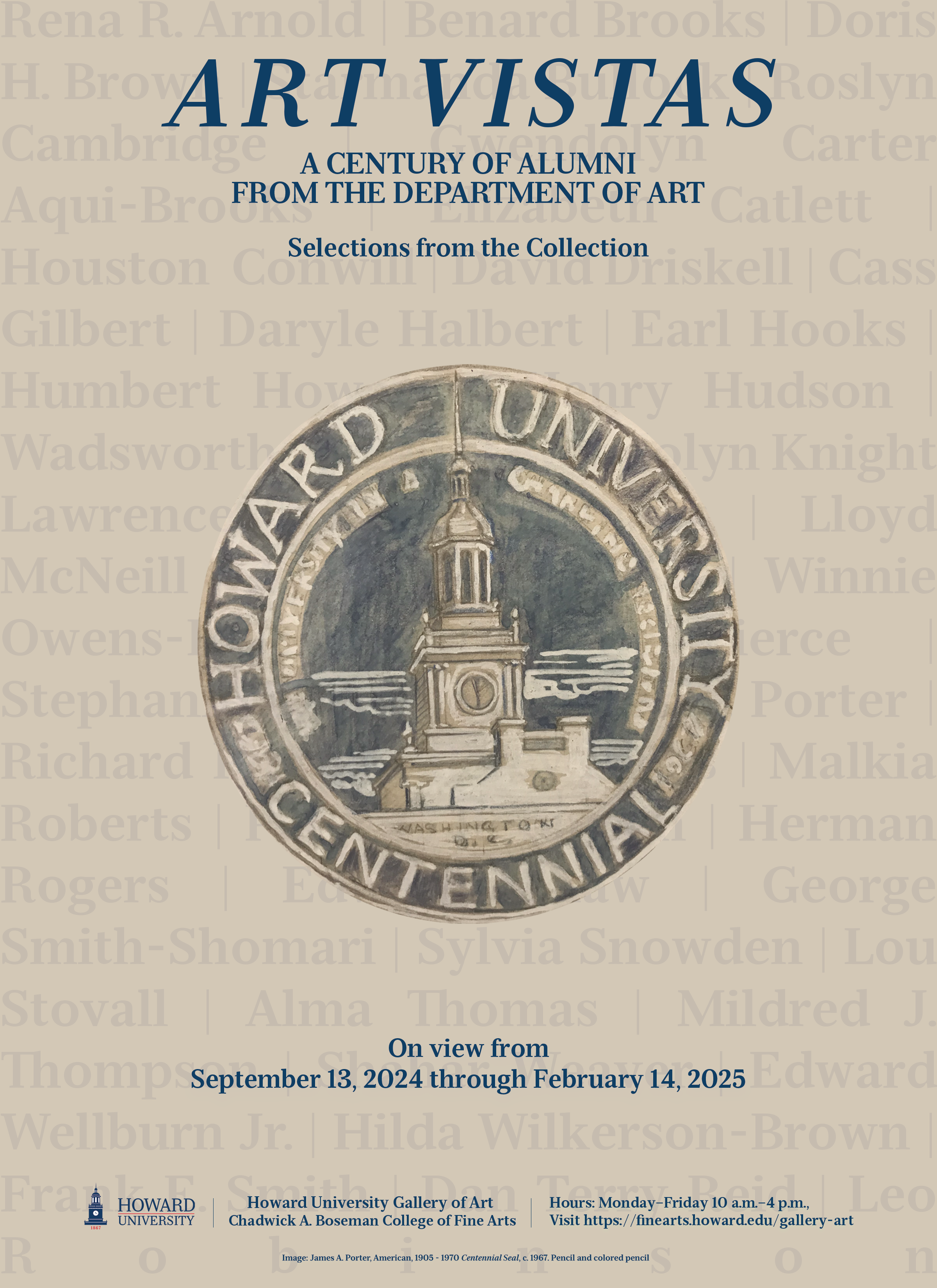
Art Vistas
Visit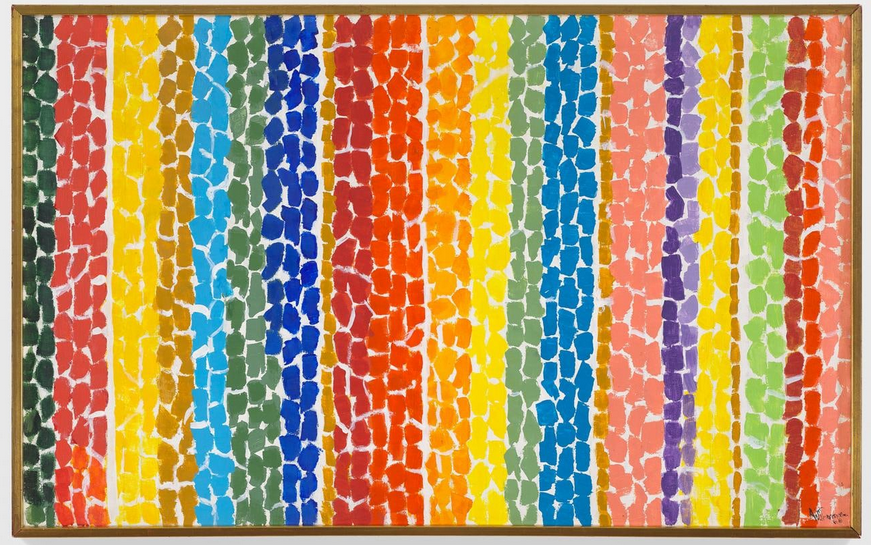
James V. Herring Heritage Gallery
Visit